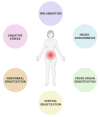Endometriosis, Pain, and Related Psychological Disorders: Unveiling the Interplay among the Microbiome, Inflammation, and Oxidative Stress as a Common Thread
- PMID: 38928175
- PMCID: PMC11203696
- DOI: 10.3390/ijms25126473
Endometriosis, Pain, and Related Psychological Disorders: Unveiling the Interplay among the Microbiome, Inflammation, and Oxidative Stress as a Common Thread
Abstract
Endometriosis (EM), a chronic condition in endometrial tissue outside the uterus, affects around 10% of reproductive-age women, significantly affecting fertility. Its prevalence remains elusive due to the surgical confirmation needed for diagnosis. Manifesting with a range of symptoms, including dysmenorrhea, dyschezia, dysuria, dyspareunia, fatigue, and gastrointestinal discomfort, EM significantly impairs quality of life due to severe chronic pelvic pain (CPP). Psychological manifestations, notably depression and anxiety, frequently accompany the physical symptoms, with CPP serving as a key mediator. Pain stems from endometrial lesions, involving oxidative stress, neuroinflammation, angiogenesis, and sensitization processes. Microbial dysbiosis appears to be crucial in the inflammatory mechanisms underlying EM and associated CPP, as well as psychological symptoms. In this scenario, dietary interventions and nutritional supplements could help manage EM symptoms by targeting inflammation, oxidative stress, and the microbiome. Our manuscript starts by delving into the complex relationship between EM pain and psychological comorbidities. It subsequently addresses the emerging roles of the microbiome, inflammation, and oxidative stress as common links among these abovementioned conditions. Furthermore, the review explores how dietary and nutritional interventions may influence the composition and function of the microbiome, reduce inflammation and oxidative stress, alleviate pain, and potentially affect EM-associated psychological disorders.
Keywords: chronic pelvic pain; diet; endometriosis; inflammation; microbiome; nutrition; oxidative stress; psychological disorders.
Conflict of interest statement
The authors declare no conflicts of interest.
Figures


References
-
- Machairiotis N., Stylianaki A., Dryllis G., Zarogoulidis P., Kouroutou P., Tsiamis N., Katsikogiannis N., Sarika E., Courcoutsakis N., Tsiouda T., et al. Extrapelvic endometriosis: A rare entity or an under diagnosed condition? Diagn. Pathol. 2013;8:194. doi: 10.1186/1746-1596-8-194. - DOI - PMC - PubMed
Publication types
MeSH terms
LinkOut - more resources
Full Text Sources
Medical

